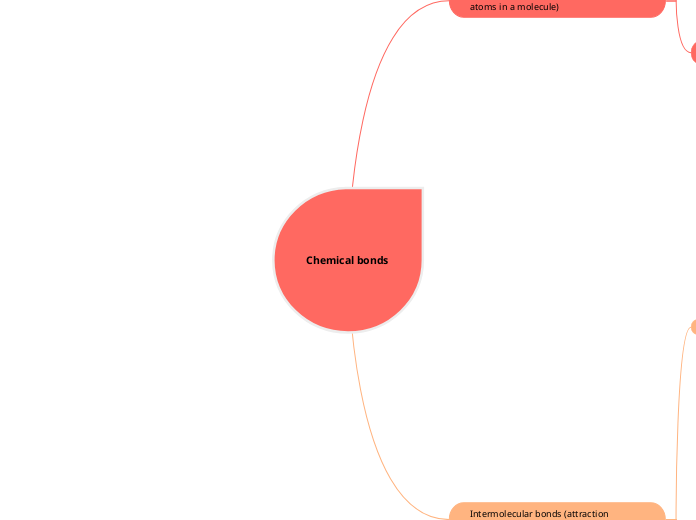Chemical bonds
Intramolecular bonds (bonds between atoms in a molecule)
Covalent bonds (sharing of electrons)
Polar covalent
No electronegative difference so the electrons are shared equally
Example: H2O
The Oxygen has a higher electronegative pull so gains a partial negative and the Hydrogen gains a partial positive because being pulled by Oxygen.
Nonpolar covalent
Difference in electronegativity making the electrons unequally shared
Example: CH's
There is no difference in their electronegativity so no pull and no partial charge.
Ionic bonds (difference in electronegativity making it a complete charge)
Example: Na+ and Cl-
Na+ loses the one valence electron to complete the octet rule giving it one more proton than electrons
Cl- gains one electron to give it 8 valence electrons giving it one more electron than proton.
Intermolecular bonds (attraction between molecules) generally weak
Dipole-dipole interaction
The interaction between polar and polar molecules.
Example
Example: Hydrogen bonds
polar molecules interaction with Hydrogen atoms bonded to either F, O, or N because they have a high electronegativity.
water properties
Cohesion and adhesion
Cohesion- hydrogen bonds in water sticking to other water molecules.
Surface tension- the cohesion of water molecules hydrogen bonds ability to hold the surface of a liquid.
Adhesion- Hydrogen bonds clinging to other molecules
High specific Heat
The ability for heat to absorb or lose some of the substance to change its temperature
Water molecules abosrbe heat and break hydrogen bonds but they are close enough to reform and release heat. No kinetic heat increase
helps moderate temperature
High heat of vaporization
water absorbing a high amount of heat breaking hydrogen bonds to not reform but vaporize (gas) leaving cool molecules back
Expansion upon freezing
As temperatures decrease the hydrogen bonds start to expand away from each other forming the hydrogen bonds not breaking them.
Ice has a greater volume than its liquid form
So the ice will float in water and has the ability to insulate the temperature below ice so that organisms can still exist
Denser as a liquid than solid
water has a lower volume than ice so ice would float. So then water would have a higher density than ice. Creating a crystal structure
Universal solvent
Polar or ionic
nonpolar
pH
acidic
less than 7 with a higher H+ concentration
neutral
equal to 7 balance for organisms to live
basic
more than 7 with a lower H+ concentration
Example
Ion-dipole interaction
The interaction between polar and ionic molecules
Example: Na+ CL- and water molecules
the opposite partial charges are attracted to the opposite complete charge
Hydrophobic interaction
nonpolar molecules interaction when placed in a polar environment
Example: CH's in water
The CH's gather in an mutual agreement because they dislike water.
Van der Waals
weak interaction with nonpolar molecules
the electrons are not distributed evenly and create partial charges on each of the atom attracting as they get closer together.
